Transformer Oil Leaks: 5 Ways You Can Stop Them
Over time Transformers age, developing leaks from old gaskets, corrosion, and stressed joints, as well as a slew of other issues that can worsen.
Transformers and all oil-filled power distribution devices are classified as oil-filled operating equipment under the EPA’s Spill Prevention, Control, and Countermeasures (SPCC) rule. Part 112.2 of the 40 CFR defines this.
As a result, if you want to capture transformer leaks and spills, you’ll have to follow those rules. This should cover everything from minor drops to catastrophic disasters.
Here are some suggestions for preventing transformer oil leaks:
- Trays. Anything from poly trays beneath the transformer to concrete structures surrounding the transformer can be used to collect and contain any drips or spills.
- Barriers. Dikes, berms, and other collection systems are examples of barriers that can keep transformer oil from escaping.
- Sealing. Welding cracks, replacing gaskets, and applying sealing materials can all be done in a variety of ways. However, they are expensive and necessitate a high level of technical expertise.
- Oil. One option is to utilise dry-type transformers and avoid using any oil at all. Unfortunately, this can be costly. Another option is to use ecologically friendly oils that do not necessitate costly mitigation measures like soil removal after cleanup.
- Water: Rainwater can be particularly difficult to deal with in outdoor installations. Filtration and pumps are required for large trays and barriers to remove water and avoid oil and water overflow.
Whenever there’s oil and water, we recommend our Sopup coco absorbants.
The Sopup coco absorbant is ideal for collecting transformer oil leaks. Its laminated bottom layer prevents oil from leaking through. Plus, they are engineered to absorb oils in the outdoors…rain or shine. With the absorbant, we have solutions for every type of spill or leak.
Check out our oil sorbents page for more information and our previous blog to learn more about what is the best way to clean up oil spills in the rain.
